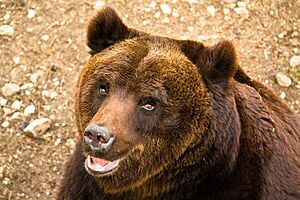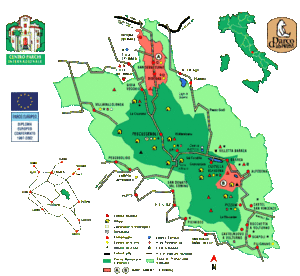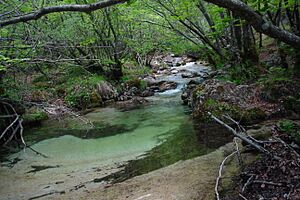Marsican brown bear facts for kids
Quick facts for kids Marsican brown bear |
|
|---|---|
 |
|
| Conservation status | |
| Scientific classification |
|
| Kingdom: | Animalia |
| Phylum: | Chordata |
| Class: | Mammalia |
| Order: | Carnivora |
| Family: | Ursidae |
| Genus: | Ursus |
| Species: | |
| Subspecies: |
U. a. marsicanus / arctos
|
| Trinomial name | |
| Ursus arctos marsicanus / arctos Altobello, 1921
|
|
The Marsican brown bear (Ursus arctos arctos) is a special type of Eurasian brown bear. It is also called the Apennine brown bear. In Italian, its name is orso bruno marsicano. This bear is in serious danger of disappearing forever.
These bears live only in a small area of Italy. Their home is mainly the Parco Nazionale d'Abruzzo, Lazio e Molise and the areas around it. The Marsican brown bear looks a bit different from other brown bears. It also has unique ways of sleeping through winter. Its name comes from Marsica, a historic area in Abruzzo where these bears have lived for a long time.
Because there are so few of them, the Italian government is working hard to protect them. The national park has become a safe place for animals like the Marsican brown bear. People hope to help these large, shy bears thrive again. Scientists sometimes discuss if it should be seen as its own unique type of bear.
Contents
What Makes the Marsican Brown Bear Special?
The Marsican brown bear lives a quiet, isolated life. There are only about 50 bears left in the Parco Nazionale d'Abruzzo, Lazio e Molise. They have some features that make them different from other brown bears.
These bears are known for being calm. They usually do not act aggressively towards humans. Male Marsican brown bears are quite large. They can weigh around 217 kilograms (478 pounds). Females are much smaller, weighing about 140 kilograms (309 pounds).
Diet and Habits
Marsican brown bears are omnivores. This means they eat both plants and animals. They mostly eat berries. Sometimes, they might eat small animals like chickens or other farm animals. Their isolated life likely plays a part in these habits.
When standing, a Marsican brown bear can be up to two meters tall. Their large size helps tell them apart. Their front paws also look different from their back paws. You can spot their presence by looking for their footprints, hair, droppings, and claw marks.
These big mammals have been seen rolling over rocks to find insects. They also reach high into branches for berries and honey. Their excellent sense of smell helps them find food. This makes up for their average eyesight.
Winter Sleep
A special thing about the Marsican brown bear is how it hibernates. They do not sleep all winter without waking up. Instead, they wake up at times. This means they are less sleepy when spring arrives.
Over the years, the Marsican brown bear became a symbol of the Parco Nazionale d'Abruzzo, Lazio e Molise. It even gave its name to "bear bread" (pan dell'orso) and other local foods. Because of the bears, more people visit the Abruzzi region for nature tourism. However, bears sometimes still have conflicts with shepherds and honey farmers. Long ago, hundreds of bears lived in these mountains.
Marsican Brown Bear Behavior and Life Cycle
The Marsican brown bear acts much like other brown bears. These bears are mostly active at night. They are very independent, except when they are with their cubs or mating.
Reproduction and Cubs
Mating season for these bears is usually from May to July. Cubs are born in early winter, around February each year. A mother bear usually gives birth to one to three cubs. Newborn cubs weigh less than 500 grams (17.6 ounces). Their size depends a lot on their mother's size.
Marsican brown bear cubs grow very quickly. This is because their mother's milk is rich in fat. This allows them to become independent after only a few months. On average, cubs stay with their mothers for a little over a year. Female bears can have babies when they are about three years old.
As they get older, these bears develop excellent hearing and smell. These senses help them find food and move around their home. However, their eyesight is just average.
What Do Marsican Brown Bears Eat?
As cubs grow, they start eating more plants. Their diet includes grass, fruit, and berries. Since they are omnivores, this plant-based diet is common for this type of brown bear.
The bear's favorite food is the buckthorn berry. They eat a lot of these in late summer in the Abruzzo park mountains. Their diet also includes meat. They eat dead animals and sometimes hunt wild animals. They are not usually seen as dangerous to people. However, they might sometimes hunt domestic animals like sheep, chickens, or turkeys. Besides eating, the Marsican brown bear also looks for a dry, safe place to spend the winter.
The Marsican Brown Bear's Home
The few remaining Marsican brown bears live in the Parco Nazionale d'Abruzzo, Lazio e Molise. This park has high mountains, thick forests, and many rivers and lakes. Small villages are scattered throughout the area.
Bears usually prefer wooded areas. But it is not unusual for them to go to high grasslands or farms in the valleys. They might stay in one main area for a while. Or they might move around a lot, searching for food.
There are only about 50 of these bears left. This is mainly because they have lost their natural homes. Bears are often killed by accident. This can happen if they are poisoned, poached, or hit by cars.
Winter Preparations
In summer, bears often travel to high mountain meadows in Abruzzo. When temperatures drop, they move down to warmer valley areas. As it gets colder, the bears start looking for a safe place to spend the winter.
In their dens, they relax and slow down. They need less food and get used to the colder weather. Bears stay in their dens for most of the winter. But they do not fully hibernate like some animals. Bears stay somewhat awake and aware of what is happening outside. They might even take a walk on a sunny winter day.
During this time, the fat they built up all year becomes very important. They need enough fat to burn for energy to stay alive. This extra fat also helps keep them warm.
Overall, these bears are good at living alone. They do not face many threats in their environment, except from poachers. Since they are omnivores, these bears can live in different types of habitats. They can do well as long as they are not disturbed often and have enough food nearby.
Where Can You Find Marsican Brown Bears?
The Marsican brown bear population is small and lives in one area. They are found in the central Apennine Mountains in Italy. This area has lakes, forests, and small towns. They mostly live in the Parco Nazionale d'Abruzzo, Lazio e Molise. This park includes valleys and part of the Apennine Mountains. This protected area might be why this endangered bear stays there.
This part of Italy has many beechwood forests, which bears love. You can also find grasslands and meadows at higher places. These bears might also be seen in nearby parks. These include Sibillini National Park, Gran Sasso-Laga National Park, Sirente-Velino Regional Park, and Simbruini Regional Park.
The area where Marsican brown bears live has shrunk a lot over hundreds of years. Since they live in an isolated place, their population is smaller than other brown bears. But they have been close to extinction for decades. In the 1980s, there were about 100 of them. Now, there are only about 43 bears on average. Only about 10 to 12 of these female bears can have cubs. Italian government officials are very concerned about their critical danger. Their extinction is still a real possibility.
The Marsican brown bear is completely separate from other brown bears. The closest ones are Eurasian brown bears in the Italian Alps. However, the Marsican brown bear could spread to other suitable habitats in the Apennines.
Protecting the Marsican Brown Bear
The Marsican brown bear is a type of brown bear. It is listed as "Critically Endangered" by the IUCN Red List. It is also protected by the Convention on International Trade in Endangered Species (CITES). People have started to understand and support the need to protect these bears. Nature tourism has also made protecting these areas more urgent.
Italy officially started protecting the Marsican brown bear in 1923. They did this by creating the Parco Nazionale d'Abruzzo, Lazio e Molise. This park has greatly helped save the bears. The park makes sure their homes stay safe or grow. They also provide more food for the bears. And they create rules to reduce problems between bears and humans. Another effort by Italians is the PATOM (Piano d'Azione Nazionale per la Tutela dell'Orso Bruno Marsicano). This plan was made to help protect the bears.
In 2001, the Italian Ministry of the Environment created a plan to save the Marsican brown bear. A main goal was to collect health information about the bears. They studied common diseases in the area. They paid special attention to diseases that could affect the bears and other local wildlife.
Until 2014, Italy and the European Union worked together to protect the bears. This project was called the Life Arctos Project. The European Union helped pay for it, costing about $7.3 million. They planted trees closer to the hills, away from people. This helped prevent bears and humans from meeting. They also put up electric fences around farms and vegetable gardens. This pushed the bears away from human areas. Moving them higher into the mountains helps keep bears and humans apart. It also helps replace food sources that were slowly disappearing.
Hunting has been a problem for bear conservation, whether legal or illegal. However, illegal hunting has decreased. This means the bear population might be growing. One way to protect them is to control how land will be used in the future. There are also talks about preventing diseases from farm animals from spreading to the bears. People also suggest more plans to protect their homes and food.
The IUCN says that brown bears as a whole are "Least Concern." But some types, like the Marsican brown bear, are "Critically Endangered."





